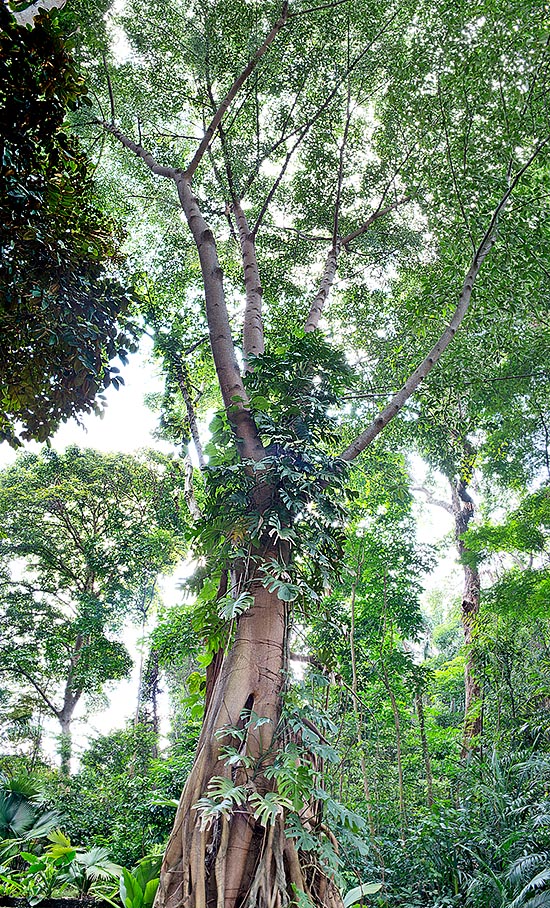Family : Moraceae

Text © Pietro Puccio

English translation by Mario Beltramini

Native to Borneo, Java, Peninsular Malaysia, Philippines, Singapore and Sumatra the Ficus kerkhovenii is an imposing tree that can be 40 m tall of pluvial forests © Giuseppe Mazza
The species is native to Borneo, Java, Peninsular Malaysia, Philippines, Singapore and Sumatra where grows in the pluvual forests at low and medium altitudes.
The name of the genus is the Latin one utilized for the common fig (Ficus carica); the species is honoured to the Dutch manager and entomologist A.E. Kerkhoven (1858-1924).
Common names: Johor fig (English).
The Ficus kerkhovenii Koord. & Valeton (1906) is a semi-epiphytic or terrestrial monoicous tree with ample canopy and brown-pinkish bark, up to 40 m tall, provided of tabular roots at the base (flattened roots similar to buttresses that contribute to the support of big trees) and contractile aerial roots that once reached the soil tend and enlarging, up to more than 1 m of diameter, form a sort of adventitious trunks.
The leaves, on a 2-3 cm long grooved petiole, are simple, alternate, ovate-oblong with pointed apex and entire margin, 8-18 cm long and 3-8 cm broad, of glossy intense green colour above, opaque below, with central nervation and 7-12 parallel lateral nervations of pale green colour and prominent below.
The leaves during the initial phase of growth are protected by a stipule (appendage at the base of the leaf), 1-2 cm long, of green colour that spontaneously detaches at the moment of the distension.
The inflorescences are syconia, that is cavities of the fleshy walls wholly enclosing the flowers, accessible from an apical opening, of about 2 mm of diameter, enclosed by 3 tiny scales. The syconia, on the young branches, are axillar, sessile, solitary or in pair, globose, of 0,8-1,2 cm of diameter, of orange to purple red when ripe colour; produced in quantity represent an important alimentary ressource for the fauna of the forest.
For the fructification is necessary the presence of the pollinating insect, as is known to each species of Ficus is associated one specific insect of the family of the Agaonidae (in our case the Eupristina leightoni Wiebes, 1992), that, in turn, can reproduce only if is present the species of Ficus to which is associated; the fruits (achenes) contain only one seed.
Besides as terrestrial, it can initially grow as epiphytic on other trees, from seeds deposited on the highest branches by birds, bats and other mammals that eat its fruits, wrapping its trunk with the roots that with the time reach the soil, and that possibly end up in “strangling” it after a certain number of years.
It propagates by seed, placed superficially on organic, sandy substratum, maintained constantly humid, in luminous position at a temperature of 24-28 °C; can reproduce also by cutting in spring and by air layering in early summer.
Imposing species with the characteristic aerial roots suitable for parks and gardens of great extension of the tropical and humid subtropical climate zones, its cultivation may be tried in the milder temperate-warm ones. During the implanting phase, due to the superficial and invasive rooting apparatus, is to be carefully evaluated its collocation that must be sufficiently far from constructions, sidewalks, sewers and roads.
It requires a full sun exposition and draining soils rich of organic substance maintained almost constantly humid, even if, when adult, can bear periods of drought. Young plants can be cultivated in pot for the decoration of particularly luminous ambients with lowest winter values of temperature over the 14 °C.
The contact with the milky sap may cause allergic reactions in particularly sensitive persons.
Synonyms: Ficus lamaoensis Merr. (1921).
→ To appreciate the biodiversity within MORACEAE family and find other species, please click here.
